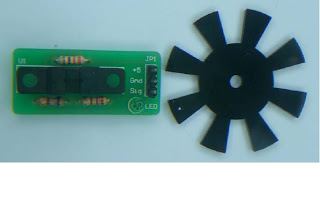In this project design, the client requires us to do a test board for the stepper motor. Inside the test board, microcontroller should be used to control the speed of the stepper motor. A microcontroller is a single integrated circuit with central processing unit (ranging from small and simple 4-bit processors to complex 32- or 64-bit processors). It contains the serial input/output such as serial ports (UARTs). It has the peripherals such as timers, event counters, PWM generators, and watchdog . In addition, microcontroller has volatile memory (RAM) for data storage and clock generator which often an oscillator for a quartz timing crystal, resonator or RC circuit . It includes analog-to-digital converters.. It requires in-circuit programming and debugging support.

Photo above shows a example of a microcontroller
In every stepper motor, it must have a pulse to generate the stepper motor. As a result the client requires us to build the pulse generator to the stepper motor. Pulse generators can either be internal circuits or pieces of electronic test equipment used to generate pulses.
Beside that, the client requires us to have a motor driver to drive the stepper motor. Stepper motor performance is strongly dependent on the drive circuit. Torque curves may be extended to greater speeds if the stator poles can be reversed more quickly, the limiting factor being the winding inductance. To overcome the inductance and switch the windings quickly, one must increase the drive voltage. This leads further to the necessity of limiting the current that these high voltages may otherwise induce.
 Photo above shows a example of a stepper motor
Photo above shows a example of a stepper motor
 Photo above shows a example of a motor driver of a stepper motor
Photo above shows a example of a motor driver of a stepper motor Inside the test board, it must contain the encoder to calculate the speed of stepper motor and display it at LCD display. An encoder is a device used to change a signal (such as a bitstream) or data into a code. The code may serve any of a number of purposes such as compressing information for transmission or storage, encrypting or adding redundancies to the input code, or translating from one code to another. This is usually done by means of a programmed algorithm, especially if any part is digital, while most analog encoding is done with analog circuitry.
 Photo above shows a example of a encoder
Photo above shows a example of a encoder
After calculate the speed of the stepper motor, the value of the speed should be displayed in LCD screen in the test board of the stepper motor.

Photo above shows a example of a LCD Screen
We combine all the client‘s requirement for the test board for stepper motor, the test board should have a pulse generator to generate the pulse, motor driver to drive the stepper motor, encoder to calculate the speed and LCD screen to display the speed of stepper motor.



 Wave Stepping Wave stepping is another method of full stepping, but with reduced power requirements (and corresponding torque output) since only one winding is powered at a time. The current required in each winding is either -Imax, 0 or +Imax. A step sequence of 4 full steps makes up one complete step cycle. Note that these full step positions are the same as the even numbered positions from the half stepping sequence.
Wave Stepping Wave stepping is another method of full stepping, but with reduced power requirements (and corresponding torque output) since only one winding is powered at a time. The current required in each winding is either -Imax, 0 or +Imax. A step sequence of 4 full steps makes up one complete step cycle. Note that these full step positions are the same as the even numbered positions from the half stepping sequence.
 Microstepping - square path
Microstepping - square path 











 Photo above shows a example of a motor driver of a stepper motor
Photo above shows a example of a motor driver of a stepper motor  Photo above shows a example of a encoder
Photo above shows a example of a encoder
.JPG)
.JPG)
.JPG)
.JPG)
.JPG)